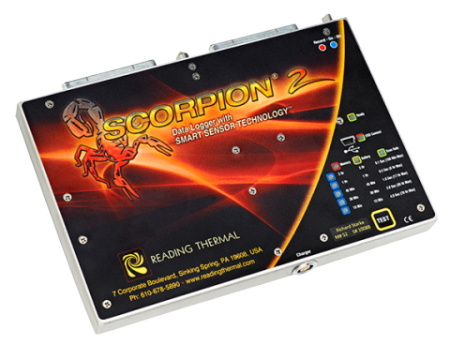Don’t ignore the performance of your industrial bakery oven. The SCORPION® 2 Profiling System and Data Logger from Reading Thermal provides the critical information you to understand and improve the proofing, baking, cooling, and freezing processes that affect your products.
The experts at Reading Thermal, a Reading Bakery Systems brand, have researched and investigated the commercial baking process for more than 25 years. Our team of heat transfer experts developed the SCORPION® 2 Profiling System and Data Logger, now an industry standard that measures and maps essential baking parameters, such as temperature and humidity, that affect the quality of your products.
Why Temperature Profiling is Important?
Product level temperature throughout an oven can make the difference between optimum quality and throughput – and wasteful, under-baked, or burnt product. The process of fermentation, product swelling, moisture evaporation, flavor development, and surface coloring are all time and temperature dependent. For example:
- Too little heat during baking can cause crusts to be brittle or dry,
- Too little heat during baking can create products that are too light in color.
- Too little heat during baking can create a structure that is too dense.
- Too much heat can cause the bottoms of the loaves to burn before the crusts brown correctly.
- Too much heat will cause moisture to evaporate too rapidly, and the dough to rise unevenly.
Why Humidity Profiling is Important?
Products passing through a thermal process interact with the amount of moisture in the environment. This moisture often comes from the product itself and represents a delicate balance that affects the quality of finished products in many ways. For example:
- High oven humidity can increase the volume of your baked goods.
- The moisture left in a pretzel after baking impacts its shelf life.
- Reducing evaporation can keep the surface of a cookie moist, allowing it to stretch without cracking.
- High oven humidity can lighten the crust color of baked goods.
- Some products need to maintain surface condensation to produce a concentrated sugar solution that gives the surface a glaze.
- The amount of moisture in a finished product can directly affect breakage during the packaging process.
How to Measure Oven Temperature & Humidity
The Reading Thermal SCORPION® 2 Temperature Sensor Array is connected to the SCORPION® 2 Data Logger and travels through a fully loaded oven with the product, delivering a true representation of temperature from side-to-side and end-to-end. Different types of pluggable sensors are available, including one designed for solid or tight mesh conveyors and one for open mesh conveyors.
The SCORPION® 2 Humidity Sensor measures the absolute moisture content of the thermal environment in both heating and cooling processes. The sensor travels through the oven with your product, yielding a precise profile of moisture experienced by the product. Mechanically, the humidity sensor has a high temperature moisture sensor, a low temperature moisture sensor, and a bulk air or dry bulb temperature sensor.
Oven temperature and humidity have a significant impact on the quality and consistency of your products. The SCORPION® 2 Profiling System and Data Logger from Reading Thermal will help you bake your products to perfection. Contact us online, or call us at (610) 678-5890 Ext. 2 for more details about our innovative products.

